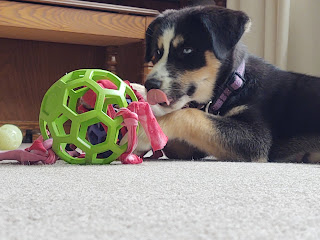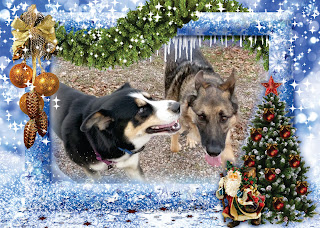Using Tug to Teach Retrieve
I find it much easier to teach a puppy to retrieve than an older dog, but I’ve also taught older dogs to retrieve objects. With puppies, I start by teaching them to love a game of tug by making their toys come to life. Once the dog loves to play tug, I develop a 2 toy game where you switch rapidly back and forth between toys. I will play tug for a few seconds then when the pup drops the toy automatically, I’ll toss the toy a few feet away. Most often the pup will grab the toy, at which point I present the other toy making it more fun which gets the puppy coming back to me and dropping the first tug somewhere along the way. I will play this game a few days in a row before I work toward getting the pup to bring the tug all the way back to me, dropping it near me then eventually dropping it in my hand. During this game, I’m not using any cues for Get It, Drop, Bring It…only happy, engaging words.
Here is a video compilation showing how I move away from tug towards other objects to keep playing the retrieve game.
I like to start with an empty bottle because it’s part of my socialization items list and it’s something that I will eventually teach my Service Dog to retrieve on a regular basis. I will then play toss and tug the bottle. After just a few sessions, my puppy is typically bringing the bottle right back to me. But there are few things you can do if your puppy is not returning to you. To build up more speed try tossing the bottle just a foot away from you so you can pretend to beat the puppy to the bottle. To get the hand delivered retrieve try waiting with the second toy, presenting it right as your puppy gets back to you and placing your other hand under to catch the bottle that is being dropped. To build distance try tossing the item a little further each time.
Once I’m getting several successful bottle retrieves in each session, I will start switching to other objects. I’ve found a small box, such as a travel size toothpaste box, is easy for a puppy to grab and they tend to think it’s just another toy. I’ll also try an empty medicine bottle or small bowl which is my trick for teaching an older dog how to retrieve. At that point I will start using some common items such as my keys that have something non-metal on them, phone, glove, etc.
Want to learn more about how I trained Azul to do his Service Dog Tasks?
Check out my +R SD Tasks Group.







.png)


